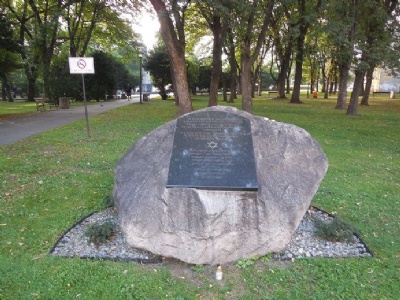Rzeszów Ghetto
Rzeszow in southeastern Poland was occupied by the Germans on September 10, 1939. At that time, about 15,000 Jews lived in the city, which corresponded about a third of the entire population. Between 1,200 – 1,700 of these fled east before the city was occupied. However, many were captured by the Germans and brought back to Rzeszow. Rzeszow became a part of the General Government and the germans immediately introduced anti-Semitic laws which drastically made life worse for Jews. At the end of September 1939, synagogues and Jewish cemeteries were vandalized ans Jews were forced into slave labor. At the end of October, a law was introduced that all male Jews between the ages of 14 and 60 had to sign up for work.
In December 1939, a law was introduced that all Jews in the General government must wear a white armband with a blue star of Ddavid on their right arm as a form of identification when they were outside their homes. By the end of 1939, there were dozens of Jewish labor camps in and around Rzeszow. In May, 1940, Jewish homes were confiscated and Jews were no longer allowed to move freely in the city. In February, 1941, the city’s name was changed to Reichshof, and in June 1941, german authorities began to prepare the transfer of the Jews to a ghetto. In 1942, a ghetto was set up for the remaining 12,000 Jews. The ghetto was shielded off from rest of the city and only with special (working) documents could Jews leave the ghetto for work. Many Jews worked as slaves in a factory (Lisia Gora) that manufactured parts for airplanes.
By June 1942, another 10,000 Jews from nearby villages and towns had been sent to the ghetto. Crowded housing, lack of water, food, medicine, heat and inadequate sewage resulted in epidemics in which hundreds of Jews died. In July 1942, the Nazis began its first (murder) action when they took about 2,000 unproductive (usually old and sick) Jews to a forest north of Rzeszow called Glogow (german Rudna). There the Germans shot the Jews and buried them in mass graves. About 14,000 Jews were deported from the Staroniwa station to the extermination camp in Belzec. A second action was carried out in August when about 1,000 Jews were sent to various labor camps. After these actions a new smaller ghetto was set up.
In 1942, a third action took place when 2,000 Jews were sent to Belzec. After that the number of Jews was reduced to about 3000 and the ghetto was divided into two ghettos (or camps) called ghetto A and ghetto B respectively. In September 1943, most of the people in the ghetto were sent to the Szebnie labor camp, about fourty kilometres southwest of Rzeszow. In November 1943, the remaining Jews in both ghettos were sent to Auschwitz where most were murdered. The ghetto was then liquidated. Of approximately 15,000 Jews who lived in Rzeszow in September 1939, about 100 survived the war.
Current status: Rebuilt with monument (2015).
Address: Boznicza 2, 35-064 Rzeszów.
Get there: Walk from central Rzeszow.
Follow up in books: Gilbert, Martin: The Holocaust: A History of the Jews of Europe During the Second World War (1987).


The memorial is located in the old Jewish cemetery, From here the Jews who were to be deported were assembled before being forced off to the Staroniwa station for further transportation towards some extermination camp. What may be left of the buildings in the former ghetto I do not know, but probably nothing.